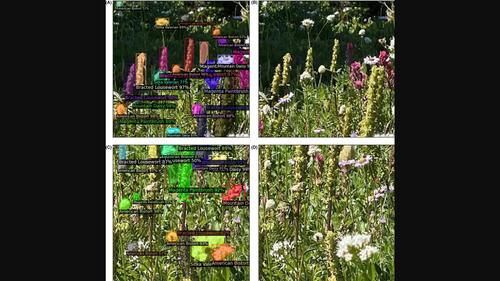当前位置:
X-MOL 学术
›
Remote Sens. Ecol. Conserv.
›
论文详情
Our official English website, www.x-mol.net, welcomes your
feedback! (Note: you will need to create a separate account there.)
Using photographs and deep neural networks to understand flowering phenology and diversity in mountain meadows
Remote Sensing in Ecology and Conservation ( IF 3.9 ) Pub Date : 2024-02-13 , DOI: 10.1002/rse2.382 Aji John 1, 2 , Elli J. Theobald 1 , Nicoleta Cristea 2, 3 , Amanda Tan 2 , Janneke Hille Ris Lambers 1, 4
Remote Sensing in Ecology and Conservation ( IF 3.9 ) Pub Date : 2024-02-13 , DOI: 10.1002/rse2.382 Aji John 1, 2 , Elli J. Theobald 1 , Nicoleta Cristea 2, 3 , Amanda Tan 2 , Janneke Hille Ris Lambers 1, 4
Affiliation

|
Mountain meadows are an essential part of the alpine–subalpine ecosystem; they provide ecosystem services like pollination and are home to diverse plant communities. Changes in climate affect meadow ecology on multiple levels, for example, by altering growing season dynamics. Tracking the effects of climate change on meadow diversity through the impacts on individual species and overall growing season dynamics is critical to conservation efforts. Here, we explore how to combine crowd-sourced camera images with machine learning to quantify flowering species richness across a range of elevations in alpine meadows located in Mt. Rainier National Park, Washington, USA. We employed three machine-learning techniques (Mask R-CNN, RetinaNet and YOLOv5) to detect wildflower species in images taken during two flowering seasons. We demonstrate that deep learning techniques can detect multiple species, providing information on flowering richness in photographed meadows. The results indicate higher richness just above the tree line for most of the species, which is comparable with patterns found using field studies. We found that the two-stage detector Mask R-CNN was more accurate than single-stage detectors like RetinaNet and YOLO, with the Mask R-CNN network performing best overall with mean average precision (mAP) of 0.67 followed by RetinaNet (0.5) and YOLO (0.4). We found that across the methods using anchor box variations in multiples of 16 led to enhanced accuracy. We also show that detection is possible even when pictures are interspersed with complex backgrounds and are not in focus. We found differential detection rates depending on species abundance, with additional challenges related to similarity in flower characteristics, labeling errors and occlusion issues. Despite these potential biases and limitations in capturing flowering abundance and location-specific quantification, accuracy was notable considering the complexity of flower types and picture angles in this dataset. We, therefore, expect that this approach can be used to address many ecological questions that benefit from automated flower detection, including studies of flowering phenology and floral resources, and that this approach can, therefore, complement a wide range of ecological approaches (e.g., field observations, experiments, community science, etc.). In all, our study suggests that ecological metrics like floral richness can be efficiently monitored by combining machine learning with easily accessible publicly curated datasets (e.g., Flickr, iNaturalist).
中文翻译:

使用照片和深度神经网络了解山地草甸的开花物候和多样性
山地草甸是高山-亚高山生态系统的重要组成部分;它们提供授粉等生态系统服务,并且是多种植物群落的家园。气候变化在多个层面上影响草甸生态,例如通过改变生长季节动态。通过对个体物种和整体生长季节动态的影响来跟踪气候变化对草甸多样性的影响对于保护工作至关重要。在这里,我们探索如何将众包相机图像与机器学习相结合,以量化美国华盛顿州雷尼尔山国家公园高山草甸一系列海拔范围内开花物种的丰富度。我们采用了三种机器学习技术(Mask R-CNN、RetinaNet 和 YOLOv5)来检测两个开花季节拍摄的图像中的野花种类。我们证明深度学习技术可以检测多个物种,提供有关拍摄的草地上开花丰富度的信息。结果表明,大多数物种在树线上方的丰富度较高,这与实地研究发现的模式相当。我们发现两级检测器 Mask R-CNN 比 RetinaNet 和 YOLO 等单级检测器更准确,其中 Mask R-CNN 网络总体表现最好,平均精度 (mAP) 为 0.67,其次是 RetinaNet (0.5)和 YOLO (0.4)。我们发现,在所有方法中,使用 16 倍数的锚框变化可以提高准确性。我们还表明,即使图片散布着复杂的背景并且未对焦,也可以进行检测。我们发现不同的检测率取决于物种丰度,以及与花朵特征相似性、标签错误和遮挡问题相关的额外挑战。尽管在捕获开花丰度和特定位置的量化方面存在这些潜在的偏差和限制,但考虑到该数据集中花朵类型和视角的复杂性,准确性还是值得注意的。因此,我们期望这种方法可以用于解决许多受益于自动花卉检测的生态问题,包括开花物候学和花卉资源的研究,因此这种方法可以补充广泛的生态方法(例如,实地观察、实验、社区科学等)。总而言之,我们的研究表明,通过将机器学习与易于访问的公开数据集(例如 Flickr、iNaturalist)相结合,可以有效地监控花卉丰富度等生态指标。
更新日期:2024-02-13
中文翻译:

使用照片和深度神经网络了解山地草甸的开花物候和多样性
山地草甸是高山-亚高山生态系统的重要组成部分;它们提供授粉等生态系统服务,并且是多种植物群落的家园。气候变化在多个层面上影响草甸生态,例如通过改变生长季节动态。通过对个体物种和整体生长季节动态的影响来跟踪气候变化对草甸多样性的影响对于保护工作至关重要。在这里,我们探索如何将众包相机图像与机器学习相结合,以量化美国华盛顿州雷尼尔山国家公园高山草甸一系列海拔范围内开花物种的丰富度。我们采用了三种机器学习技术(Mask R-CNN、RetinaNet 和 YOLOv5)来检测两个开花季节拍摄的图像中的野花种类。我们证明深度学习技术可以检测多个物种,提供有关拍摄的草地上开花丰富度的信息。结果表明,大多数物种在树线上方的丰富度较高,这与实地研究发现的模式相当。我们发现两级检测器 Mask R-CNN 比 RetinaNet 和 YOLO 等单级检测器更准确,其中 Mask R-CNN 网络总体表现最好,平均精度 (mAP) 为 0.67,其次是 RetinaNet (0.5)和 YOLO (0.4)。我们发现,在所有方法中,使用 16 倍数的锚框变化可以提高准确性。我们还表明,即使图片散布着复杂的背景并且未对焦,也可以进行检测。我们发现不同的检测率取决于物种丰度,以及与花朵特征相似性、标签错误和遮挡问题相关的额外挑战。尽管在捕获开花丰度和特定位置的量化方面存在这些潜在的偏差和限制,但考虑到该数据集中花朵类型和视角的复杂性,准确性还是值得注意的。因此,我们期望这种方法可以用于解决许多受益于自动花卉检测的生态问题,包括开花物候学和花卉资源的研究,因此这种方法可以补充广泛的生态方法(例如,实地观察、实验、社区科学等)。总而言之,我们的研究表明,通过将机器学习与易于访问的公开数据集(例如 Flickr、iNaturalist)相结合,可以有效地监控花卉丰富度等生态指标。






























 京公网安备 11010802027423号
京公网安备 11010802027423号